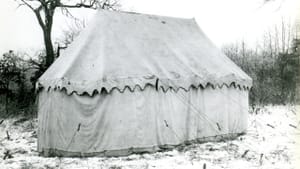Stay in the Loop
BSR publishes on a weekly schedule, with an email newsletter every Wednesday and Thursday morning. There’s no paywall, and subscribing is always free.
A travelin’ soldier
The Museum of the American Revolution explores the travels of Washington’s war tent

In this election year, the Museum of the American Revolution is asking a provocative question: what can a tent show about the leader who slept in it? Since 2017, the museum has presented George Washington’s Revolutionary War tent as a centerpiece of its collection, inviting visitors to view the tent as part of a 15-minute multi-media presentation. But curator Matthew Skic says the permanent exhibit only “scratches the surface” of the fascinating history of Washington’s tent and its path to the present.
More than just a tent
Thousands of tents were made for the Continental Army during the Revolution. Only Washington’s survived. Washington had two tents during the war—a dining tent, now in the Smithsonian’s collections, and his sleeping and office tent, which belongs to the Museum of the American Revolution. The sleeping and office tent also had an “inner chamber” to divide up the space and provide insulation; it belongs to the National Park Service.
In a certain sense, Washington’s tent is not much to look at. That’s the point, Skic explains. During the war, “Washington [was] very conscious of his image, especially as a leader of an army of the people, a republican leader.” In contrast to the “lavish, extravagant tents” of his European counterparts, Washington’s tent and furnishings were simple and practical—a foldable bed, a desk, a stool. Just like many American presidents who followed, Washington aimed to project Average Joe bona fides.
And yet, the tent was more than just a gesture; it was a workspace for Washington, who wrote thousands of letters and dispatches there during the war. The tent was at the Siege of Yorktown and many other critical turning points in the war. “It’s incredible to think about if this tent could talk,” Skic says. “We’re trying to get close to that with this exhibit.”
Arranging a reunion
To that end, the exhibit brings together over 100 artifacts, works of art, and manuscripts that expand the story of the tent, from camp furniture to utensils and drinking vessels to an original, contemporary sketch of the tent on the battlefield. “Some of these items haven’t been together since 1802,” Skic says. “This is sort of like a reunion.”
One of the major goals of the exhibit is to highlight the people who cared for the tent over time. There are stories here, from Martha Washington’s grandson entertaining up-and-coming politicians in the tent at what is now Arlington National Cemetery to Selina Gray, an enslaved woman who cared for the tent before Union soldiers confiscated it during the Civil War.
In 1824, Marquis de Lafayette, a Frenchman and key ally to Washington during the war, returned to the US for a series of parades, dinners, and balls in his honor. Lafayette was then part of a “dwindling generation” who had fought in the war. When he got to Fort McHenry in Baltimore, the tent was waiting for him, fellow veterans inside. “Over 40 years he hadn’t seen it,” Skic says. “He shed tears under the tent.” Now 200 years later, Skic hopes visitors will be similarly moved.
What, When, Where
Witness to Revolution: The Unlikely Travels of Washington’s Tent. February 17, 2024, through January 5, 2025, at the Museum of the American Revolution, 101 S 3rd Street, Philadelphia. $13-$25. (215) 253-6731 or amrevmuseum.org.
Accessibility
The museum is accessible to all audiences, and the exhibit includes special activities and resources for kids. Guests may request accommodations or additional assistance in advance. View complete accessibility information on their website.
Sign up for our newsletter
All of the week's new articles, all in one place. Sign up for the free weekly BSR newsletters, and don't miss a conversation.

 Lowry Yankwich
Lowry Yankwich